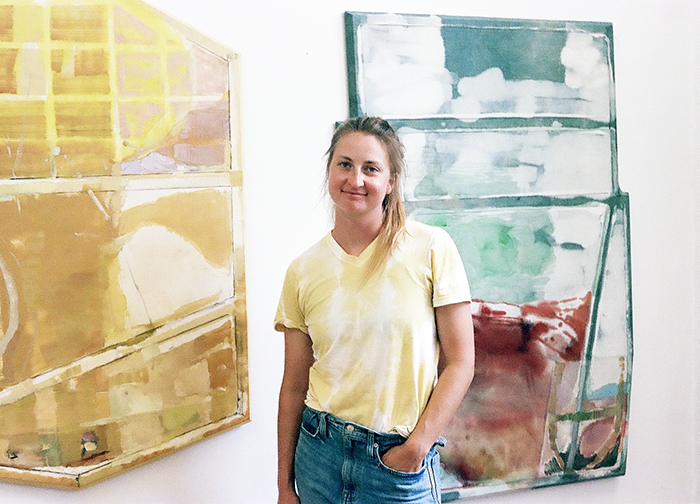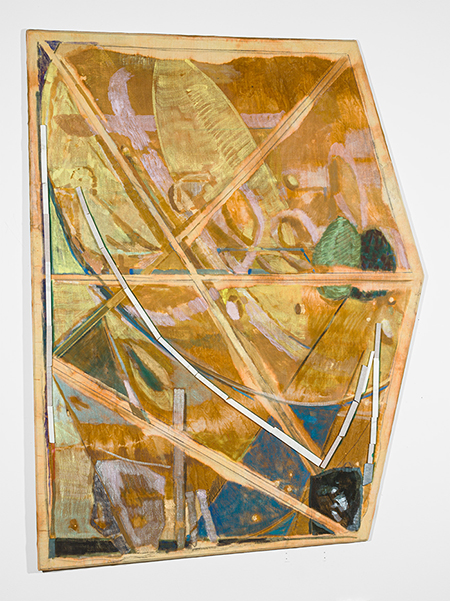Illuminating Time, Space and the Environment: Meet Eleanor Conover

Assistant Professor of Art and Art History Eleanor Conover. Photo by Camille Gunderson.
College's newest art department faculty member talks art, inspiration, teaching
by MaryAlice Bitts-Jackson
If you’re curious about Assistant Professor of Art & Art History Eleanor Conover’s exhibition, now’s your chance to learn about Dickinson’s newest art department faculty member and her work.
A collection of Conover’s paintings, Weather Reader, is on display in the Trout Gallery through Aug. 13, and on Thursday, April 21, Conover will deliver an informal discussion about her work.
Conover earned a B.A. at Harvard College; completed her MFA at the Tyler School of Art and Architecture, Temple University, in 2018; and served a post-MFA teaching fellowship at the School of Art, University of Tennessee, Knoxville. She was the 2020-21 recipient of the Wellesley College Alice C. Cole ’42 Fellowship, awarded to an outstanding early-career painter or sculptor. Recent past exhibitions include Able Baker Contemporary (Portland, Maine), Bad Water (Knoxville, Tennessee) and Ortega y Gasset Projects (Brooklyn, New York).
Conover joined the Dickinson community as assistant professor at the start of the current academic year. In the days leading up to her artist’s discussion at Trout, we asked her a few questions about her work and her time at Dickinson so far.
What can you share about the works in this exhibition?

Eleanor Conover, Birds of a Feather, 68 x 45 in., 2021.
About two-thirds of this work was made last semester, in my studio in Goodyear, in my first few months in Carlisle. The rest were made last summer in a barn in Maine, where my sister and her husband live. Both places are interesting architecturally, where the structure of the building is exposed. I feel the paintings serendipitously relate to both buildings.
What can you tell us about your artistic process?
Most of this work derives from a process that is initiated from drawings, which are a bit like fictional architectural plans, or shapes with an internal structure.
It is very hard for me to pin down a linear explanation for what has made its way into the work. On the one hand, I am very moved by the cavernous spaces of marble and granite quarries, and the way the stone is stained with rust and minerals and the cuts of human intervention, in an elegiac sense. On the other hand, I am thinking about language—for example, how imperfect rhymes are in fact a kind of satisfying failure. Color, shape, texture and line are involved in that affective logic as well.
You’ve said that your work explores themes of environmental time and space.
I tend to work in a single continuum, rather than in isolated projects, and there is no definitive “aboutness” that I am interested in teaching the viewer. Though, of course, after the fact, certain bodies of work and implied meanings do emerge. The irregular supports I use can associate with many things, including architecture, containers, fragments, land masses, awkward rocks, islands, stone structures, maps, windows, etc. I’m not saying that that was my intention when I started this work, but it is what I begin to see and think about during the process and after the fact.
I am also very interested in engaging with the fabric of canvas or linen directly, which I think kindles a haptic or tactile sense. What I am talking about is the surface, and the way the dye impregnates into the canvas—the stain becomes a vehicle to consider dispersion and the removal of control. Painting sometimes also deals with covering up and reinventing passages or images on top of other passages or images that don’t seem to be working.
What I have described above is what we, as humans, or groups of humans, do every day on this earth. We also dig to understand what has happened before. Time and space are linked in that way. It also takes time to make a painting, and marks and pours are markers of time, and in the end, we get to see them all at once, together on the surface. Of course, this is what many painters think about. But for me it is a useful way to stay close to the land, if only metaphorically, which has been a throughline in my painting for my entire life.
What sparked your interest in exploring environmental themes, generally, in your work?
I grew up in New England and was lucky enough to spend a lot of my childhood outdoors. On some nights, my mom rang a cowbell to get us to come inside for dinner. I think my sensibilities about material and my interest in environment started there. What I mean by this is that I was digging in the dirt and building things with sticks and branches. Now I am working from paint that, in many cases, came from the earth, and I am engaged not only with the image that is produced on the painting but also with how it is made and what is used to make it. I acknowledge this verbally in my materials lists.
For various reasons, it was a long time before I understood that painting the landscape was just one of many approaches to or genres of painting. When I arrived at graduate school, I was up against a very steep learning curve. I went in really defining myself as someone committed to a kind of illusionistic landscape painting, meaning that I was making more conventional images of places in perspectival space with a horizon line, sky, earth and so on. I came out of school with this sense of awe and possibility (and perhaps an odd sense of fear) about what else painting can do.
Now the work has changed quite a bit—I feel it is engaging with other lineages of painting and dealing with the medium of paint and the dialectic of flatness and illusion, as well as provoking the rectangle and the support. That medium-specific criticality feeds me intellectually and physically, but I am just now developing a sense of openness to use paint for non-objective and objective ends. In other words, the subject matter traverses through representation and abstraction more freely.
Tell us a little about your interest in coastal areas.
I grew up spending a lot of time on boats. My first job was working in a boatyard that restored wooden boats, and I basically spent the mornings vacuuming sawdust. I think in some ways I am still doing that. I have a deep connection to the water and the changing weather conditions that exist there. Maybe it is a little bit like the desert or the plains, where you can see things coming from a distance.
My partner is an actor, and they often joke about using every encounter, pleasant or unpleasant, as “material” or “research,” and I think that can be broadly true for all kinds of artists. I have had a few very intense experiences at sea, all of which have impacted my understanding of myself and time and space. I might discuss it in more detail during my talk.
I’ve read that you did some geology-related research and work at Tyler. What did this entail?
I will note that the term “research” gets tossed around a lot in the visual arts, and I feel it is sometimes a mischaracterization—or, rather, that it attempts to define or contain ways of thinking and working so that it appears to be aligned with an academic setting. In this case, I would say this word is used speculatively and discursively.
I took a course that was aimed toward collaborative processes and used a subject, rather than a discipline, as a starting point. In this instance, the subject was a metamorphic rock called schist, of which a specific kind is part of the bedrock in Philadelphia and the surrounding area—and, like the Dickinson campus, this local stone was used in the local architecture. After the course some of us continued the work, which involved thinking about what kinds of communities (geologists, masons, etc.) were invested in the building projects that took place in the late 19th and early 20th century. The architecture was a direct reflection of the environment (which is less common now; there’s a sticker on the wood that I buy to build my stretchers that tells me the wood came from New Zealand).
We visited a working quarry in Germantown one day, and we pulled over on the side of the road and the quarry was on one side of the road and there was a large graveyard on the other side of the road. I was struck by the symbolism between excavation and interment. I see painting as something that has good metaphorical potential. Sometimes the threads of this kind of research can fold into painting, and sometimes I am not sure the silence in painting can address the very specific nature of archival and historical work. I am learning to be at peace with that. And I am interested in engaging with other kinds of artistic and non-artistic work because I have found that all of that experience ends up productively inside of me.
What courses are you teaching this year?
This year I have taught Introduction to Drawing and Composition, Life Drawing, Advanced Drawing and Advanced Painting.
Do you have any hobbies, interests or hidden talents?
I am a Virgo, my favorite color is yellow and the book I finished most recently is The Parable of the Sower by Octavia Butler. We have learned, too slowly, that climate change is both an existential and intersectional concern, and Butler’s intense clarity regarding those statements as she wrote this fictional work in the early 1990s is important to note.
What do you enjoy most about teaching at Dickinson so far?
I am very glad to be here and to have the opportunity to work in the classroom with such earnest and hardworking student artists.
Teaching fuels my studio practice in many ways, and I view teaching as a great responsibility as well as a creative project unto itself. I know from experience that making art in a liberal-arts environment is sometimes a complicated endeavor, in the sense that it involves a very different kind of process from many other disciplines that are rooted in words and numbers.
Learning to paint and draw is incredibly difficult and can be at times embarrassing, personal and awkward. It’s messy and time consuming! But for me, the reward is in the dissection of how images and materials operate in visual space—the triangulation between the maker, viewer and art—and the collaborative, discursive format of critique. Students may be using paint and pencils to create art, but our conversations in critique don’t end there. We talk about what the work conjures, be it art history, self and subjecthood, language, psychology, etc., and this is backed up by the work that students do in other areas.
The Goodyear Building is a very honest and open space of history, material investigation, community and self-directed work, all of which miraculously work well together.
Can you explain what you mean by that?
I think people like the fact that, as a former factory building, the Goodyear space has visible, palpable history. Good energy occurs in the sculpture, ceramic and 2-D spaces, and a lot of it overlaps. There appears to be productive creative exchange between students who hold studios there, and it is also a space that promotes intense individual focus.
Learn more about the Trout Gallery exhibition (includes a link to the gallery exhibition brochure).
Learn about all spring exhibitions at Dickinson.
TAKE THE NEXT STEPS
Published April 19, 2022